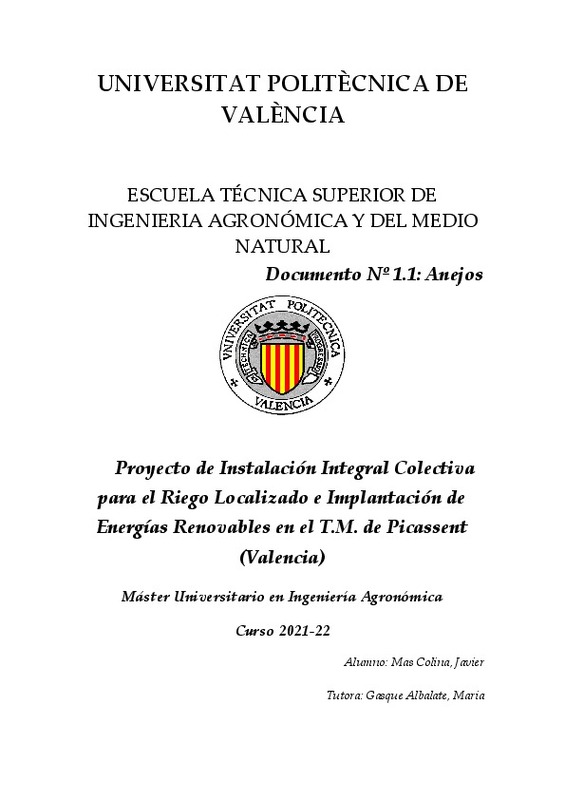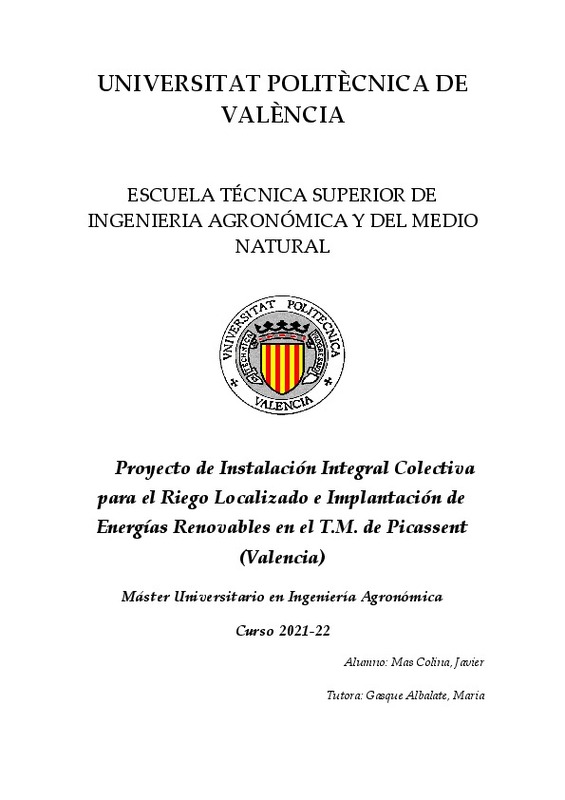|
Resumen:
|
[EN] The C.R. of Picassent has an irrigation sector of about 120 ha cultivated with citrus fruits in its great majority, all of them located in the municipality of Picassent (Valencia). The irrigation system currently ...[+]
[EN] The C.R. of Picassent has an irrigation sector of about 120 ha cultivated with citrus fruits in its great majority, all of them located in the municipality of Picassent (Valencia). The irrigation system currently implemented is a very heterogeneous and obsolete system that hinders the management of the Community of Irrigators. Therefore, through this project, it is intended to change its irrigation system towards a more homogeneous and sustainable system such as localized irrigation. This type of irrigation offers greater efficiency and produces great water savings. In addition, the C.R. has a well from which it can extract 400,000 m3 annually and which is complemented by other catchments for the irrigation of the entire surface. Currently the well is operated by a fossil fuel generator. Given this situation, an isolated photovoltaic installation is designed where the objective is that it can extract this annual volume in addition to complying with the monthly restrictions. The photovoltaic system will be arranged inside an abandoned rustic plot on a steel metal structure. This installation will reduce both fuel costs and CO2 emissions into the atmosphere by using renewable energies for water extraction. The proposed project contributes to the achievement of the following Sustainable Development Goals (SDGs) set by the United Nations 2030 Agenda Goal 6: clean water and sanitation (as it is intended to increase the efficient use of water resources in the agricultural sector). Goal 7: affordable and clean energy (as it contributes to increasing the share of renewable energy in the energy mix, as well as improving energy efficiency). More secondarily, it is also linked to Goal 13 (climate action) since it seeks the adoption and implementation of a plan to promote inclusion, the efficient use of resources, the mitigation of climate change. The inclusion of the SDGs in formal training is considered necessary for the next generations of engineers to be more aware of sustainability and the fight against climate change. With a national focus, this Project it is possible to comply with the investments in energy efficiency and renewable energies of the Environmental Sustainability Action Program, being able to request the corresponding aid to cover a part of the expenditure charged to the funds from the European recovery framework as an "environmental and digital transformation of the agri-food and fisheries sector" project integrated into component 3 of the Recovery, Transformation and Resilience Plan (PRTR) managed by the Ministry of Agriculture, Fisheries and Food (MAPA).
[-]
[ES] La Comunidad de Regantes de Picassent (en adelante C.R.), dispone de un sector de riego de 120,65 ha cultivadas de cítricos en su gran mayoría, todas ellas situadas en el término municipal de Picassent (Valencia). El ...[+]
[ES] La Comunidad de Regantes de Picassent (en adelante C.R.), dispone de un sector de riego de 120,65 ha cultivadas de cítricos en su gran mayoría, todas ellas situadas en el término municipal de Picassent (Valencia). El sistema de riego actualmente implantado es un sistema muy heterogéneo y obsoleto que dificulta la gestión del órgano de gobierno de la C.R. Por ello, mediante el presente proyecto, se pretende actualizar y modernizar su sistema de riego implantando un sistema más homogéneo y sostenible de riego localizado, que ofrece una mayor eficiencia y produce grandes ahorros de agua. Además, la C.R. dispone de un pozo del cual puede extraer anualmente 400.000 m3 y que se complementa con otras captaciones para el riego de toda la superficie. Actualmente la extracción de agua del pozo funciona mediante un generador convencional que utiliza combustibles fósiles. Ante esta situación, se diseña una instalación fotovoltaica aislada donde el objetivo es que pueda extraer dicho volumen anual además de cumplir con las restricciones mensuales. El sistema fotovoltaico se dispondrá en el interior de una parcela rústica abandonada sobre una estructura metálica de acero. Esta instalación hará reducir tanto los costes en combustible, como las emisiones de CO2 a la atmosfera, al utilizar energías renovables para la extracción del agua. El proyecto propuesto contribuye a alcanzar los siguientes Objetivos de Desarrollo Sostenibles (ODS) marcados por la Agenda 2030 de las Naciones Unidas: Objetivo 6: agua limpia y saneamiento (dado que se pretende aumentar el uso eficiente de los recursos hídricos en el sector agrario). Objetivo 7: energía asequible y no contaminante (dado que se contribuye al aumento de la proporción de energía renovable en el conjunto de fuentes energéticas, así como a la mejora de la eficiencia energética). De forma más secundaria también está vinculado con el objetivo 13 (acción por el clima) puesto que se pretende la adopción e implementación de un plan para promover la inclusión, el uso eficiente de los recursos, la mitigación del cambio climático. La inclusión de los ODS se considera necesaria para que haya mayor sensibilización con la sostenibilidad y la lucha contra el cambio climático. En ámbito nacional, se consigue cumplir con las inversiones en eficiencia energética y energías renovables del Programa de actuación de Sostenibilidad Ambiental, siendo susceptible de solicitar las ayudas correspondientes para sufragar una parte del gasto con cargo a los fondos procedentes del marco europeo de recuperación como proyecto de transformación ambiental y digital de sector agroalimentario y pesquero integrados en el componente 3 del Plan de Recuperación, Transformación y Resiliencia (PRTR) que gestiona el Ministerio de Agricultura, Pesca y Alimentación (MAPA).
[-]
|








